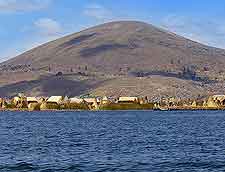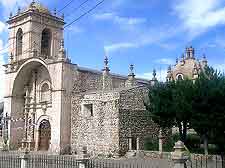Juliaca History Facts and Timeline
(Juliaca, Puno, Peru)

The city of Juliaca is the largest in the region of Puna, which is located in the south-east of Peru, on Lake Titicaca and near the border of Bolivia. Juliaca's history dates back to its official foundation in the year of 1826 and it has gradually developed to become the region's largest and most significant trade centre.
Importance of Lake Titicaca
The region was where one of Peru's most important pre-Hispanic cultures originated - the Tiahuanaco culture. Aymara groups known as the Collas, the Kallahuayos, the Lupacas and the Zapanas all inhabited the Collao plateau at one time, living around the expansive Lake Titicaca.
According to the legend of the Incas, both Mama Ocllo (an Inca fertility goddess) and Manco Capac (the Great Inca Emperor) were given instructions from the Sun God to found the ancient Tahuantinsuyo Empire, and actually rose up from Lake Titicaca's waters.
Manco Capac is said to be the first 'Sapa' Inca. He divided the Inca Empire into four separate regions known as 'suyos', which covered the entire Collao plateau, including the area where Juliaca now sits and nearby Puno. After the Titicaca region had been incorporated by the Incas and the Tahuantinsuyo Empire, the importance of this region was heightened due to the prosperous silver and gold mines located here. The breeding of llamas and alpacas (for both meat and their wool) also played an important part in the local economy, as well as the farming of potatoes, coffee and quinoa (a grain-like crop).
Arrival of the Spanish
The history of the land where Juliaca now sits saw the Spanish arrive around the middle of the 16th century. The colonists took over the established mines and began to enjoy the considerable wealth that was subsequently generated. The Laikakota Mines, located roughly 15 minutes to the west of Juliaca, were fought over during the latter years of the 17th century, with many battles taking place for ownership.

Independence History of Juliaca and Puna
After a century of relative peace, the Indian revolutionists began to fight for their independence in 1781, following the example of Tupac Katari, who had previously led the indigenous peoples' rebellions against the Spanish Empire in neighbouring Bolivia, located directly to the east. At the start of the 19th century, during the War of Independence, Puno and the surrounding region was an important settlement for the Peruvian freedom fighters.
Juliaca's Historical Attractions
Most visitors travel to Juliaca to use it as a base for exploring Lake Titicaca, the world's highest accessible lake. The city is almost 200 years old, being officially founded in 1826, and features some significant historical landmarks from its earliest days.
Among the most interesting structures from Juliaca's history are its churches. The Iglesia La Merced stands impressively in the Plaza Bolognesi and boasts a beautiful interior, while the Iglesia Santa Catalina can be found close by, within the same plaza. The latter was actually erected during the 16th century, although fire damage necessitated its rebuilding during the early 18th century.
 The city of Juliaca is the largest in the region of Puna, which is located in the south-east of Peru, on Lake Titicaca and near the border of Bolivia. Juliaca's history dates back to its official foundation in the year of 1826 and it has gradually developed to become the region's largest and most significant trade centre.
The city of Juliaca is the largest in the region of Puna, which is located in the south-east of Peru, on Lake Titicaca and near the border of Bolivia. Juliaca's history dates back to its official foundation in the year of 1826 and it has gradually developed to become the region's largest and most significant trade centre.